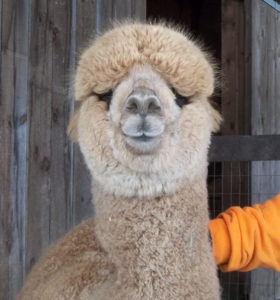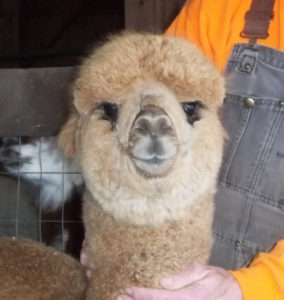This time of year usually find us beginning to halter train last year’s crias, especially those we plan to show in the spring. Only one of the crias we are currently training will be shown in the upcoming season – Snowshoe Ginger. This 9 month old fawn female is a daughter of our Champion herdsire, Snowshoe Aristides. Her fiber is fine, crimp and dense. We can’t wait to see how she does in the show ring.
But before we can bring her into the ring, she needs to learn how to walk on a lead. We start training with fitting a halter properly and leaving this on the alpaca for a short period (maybe a few minutes or a few hours for several days, depending on how the cria reacts). Once the animal seems comfortable wearing the halter, we add the lead line and begin training. This can be a fairly quick process or a lengthy one. Each alpaca reacts differently and we have different tools and tricks to help them make progress.
One important thing that we learned early on is that it’s important that the alpaca can see clearly before starting to train. A number of years ago, we took on a two year old male boarder who was not halter trained. His owner tried, but had little success with training this particular alpaca. Well, it seemed obvious to us that the guy needed a trim – he could barely see out from under his full topknot. As soon as we did that, not only did he become much less skittish, but he was easily and quickly lead trained. Note to self: always check topknots before training.
Crias often have very fleecy faces and sometimes that fleece gets in the way of their eyes. Ginger, the alpaca we just started training, is one such animal. So, before we started halter training, we quickly trimmed the topknot just above her eyes. What difference this little bit of husbandry makes, not only in training, but in any routine handling. Here are before and after photos of Ginger.



